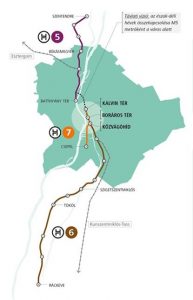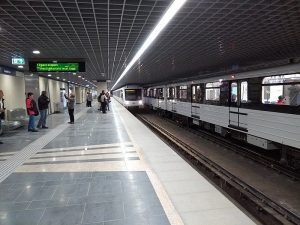 Budapest Development Centre (BFK) has announced three tenders for planning the first phase of the new metro Line 5, which involves the refurbishment of the existing suburban lines and the construction of a connection the two southern lines (H6 and H7).
Budapest Development Centre (BFK) has announced three tenders for planning the first phase of the new metro Line 5, which involves the refurbishment of the existing suburban lines and the construction of a connection the two southern lines (H6 and H7).
The first one envisages the renovation of the H6 Ráckeve line, the redevelopment of stations, the renewal of passenger information system and the construction of park and ride facility. The design tender includes the complete renovation of the H7 (Csepel) suburban line, the increase of accessibility, the installation of modern passenger information system, the modernisation of the existing stations the construction of park and ride facilities as well as the expansion of the railway connection to Erdősor út.
The planning tender envisages the construction of a railway link between the H6 and H7 suburban lines which will be underground situated from Közvágóhíd to Kálvin Square, with a new transfer link to the metro line 3 and 4, providing a direct downtown connection.
The second tender involves the renovation of the Békásmegyer – Szentendre section on the H5 line and the modernisation of the existing stations, providing increased accessibility.
The third tender envisages the design for the construction of a new tunnel which will complete the Line 5. It will be constructed under the Danube connecting the H6 and H7 lines with the H5 lines. A feasibility study on the tunnel is being prepared as part of the project which will determine the route of the north-south tunnel for the next stage of the project. The new tunnel will provide the central link to connect the three lines.
“All these three tenders will form the first phase of the metro Line 5. The concept is to connect H5, H6 and H7 lines under the city center to create a north-south rail system from Szentendre to Csepel and Ráckeve, on which MÁV suburban trains on the Esztergom and Kunszentmiklós-Tass lines will run in the future,” said Dávid Vitézy, the president of BFK.
 The project would double the number of passengers commuting by rail from the suburbs to the capital, shifting a significant road traffic to the railway transport. “Offering a competitive alternative to the car transport and providing comfortable connections, the number of passengers can be doubled,” Vitézy explained.
The project would double the number of passengers commuting by rail from the suburbs to the capital, shifting a significant road traffic to the railway transport. “Offering a competitive alternative to the car transport and providing comfortable connections, the number of passengers can be doubled,” Vitézy explained.
In parallel to the modernisation and expansion of the infrastructure, a tender for low-floor, air-conditioned trains will be announced.
Currently, the project for the Csepel, Rákckeve and Szentendre suburban lines is the most important and largest transport investment, Vitézy said. The refurbishment of the lines will increase the passenger capacity on the two southern lines (H6 and H7) from 47,000 to 108,000. According to the preliminary calculations, the travel time from Csepel to downtown will be reduced by 7 minutes, while from Ráckeve, by 30 minutes.
Share on:



